When you head to a restaurant and find a queue out the door, what do you think?
Are you reassured that this must be an exceedingly popular venue and happily join the line?
Or do you start to wonder whether service is not really efficient and walk to the restaurant across the street to check out the menu there?
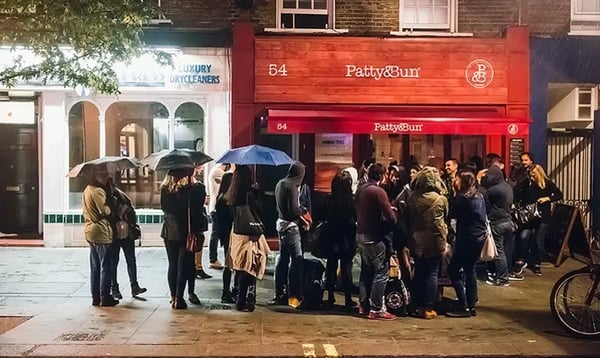
Restaurant wait times have always been a sticky issue. There are lots of things that have an impact on them, and even with the best planning, sometimes it’s simply not possible to provide an entirely wait-free service.
In this post we’ll look at a few ways to keep on top of customer flow and move guests faster through the cycle of service, making sure that a walk-in doesn’t change to a walk away.
Improving customer flow
Plan ahead. First, dig into the numbers to find patterns: are you unexplainably busy one particular midweek night each month? If so, would it be worth scheduling swing staff next time this evening comes around?
Also, keep your finger on the pulse of what’s happening in your local area. Is a popular band playing in town one night? Are schools holding their proms or are college students graduating? These are all key snippets of information when it comes to planning your staffing and marketing strategies.
Prep ahead. Consider getting together with your kitchen to produce items that don’t take too much time to get out. This can sometimes be challenging, especially if you are an establishment that offers specific cuisines.
But fear not! Saving time is all in the details. If you can put in as much prep work ahead of time in the kitchen, many minutes can be shaved off cook times.
Don’t seat incomplete parties. That party that has three people at the host stand but says they’re waiting on another three? Pass it up if you have other waiting guests and a busy waitlist. If you sit incomplete parties, it will take much longer to get a proper order.
Complete parties are more reliable to get an order in on time. What's more, they’re all already there. The last thing you want is a reservation that has been seated and is missing two or so people, who may not show up at all. Not only would that be rude, but also missed revenue for your restaurant.
Let them pay at the table. Pay-at-the-table systems save minutes too. These may seem small at first, but they add up! Your bussers will have breathing room and can clean the table properly before seating another party, and the overall flow will be much improved.
Add extra space (if you have it). Dining in Chicago in winter? Good thing there’s extra indoor seating! Sometimes prepping extra space can really go the extra mile and save you when dealing with a long waitlist. Many restaurants have spaces that they may close for breakfast or lunch services and then open for dinner when volumes are higher.
Further reading
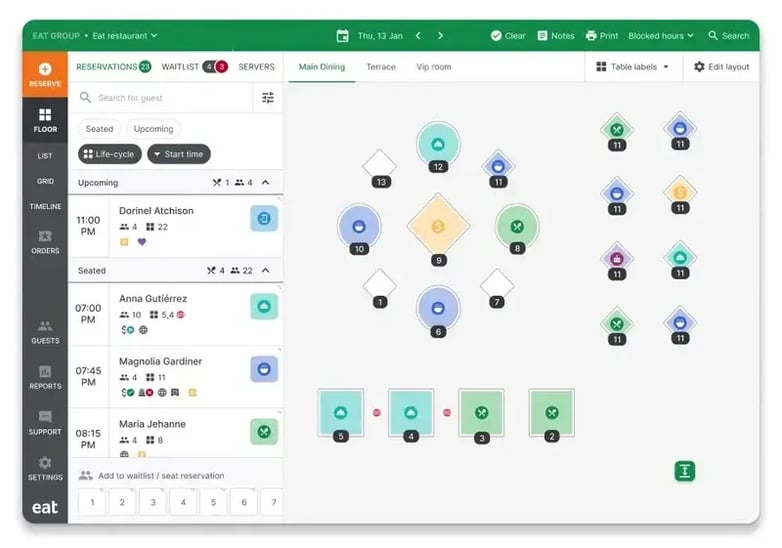
How to create a positive wait experience
The impact of restaurant waiting times is a superbly fascinating topic that many scientific studies have investigated. One of them, Bielen & Demoulin, 2007, found that setting expectations for waiting times helped to reduce the stress experienced by customers. They also concluded that uncertainty over the waiting time affected guest responses to service and that a pleasant waiting environment had a positive impact on mood and perception.
What this means is that customers' waiting experience has direct consequences on how they judge and enjoy their overall time with you. If their wait time is estimated wrongly or they spend the wait in discomfort, they could be less than forgiving, even if the food and service once seated are amazing.
Good communication, accurate time estimates, and "please wait" environments are therefore crucial for managing the waiting period well. Here are just a few ways you can enhance their waiting period.
-
Make sure the waiting area is clean and comfortable. You may want to play music or provide a good view of any entertainment on the floor
-
Provide informed estimates of how long the waiting period is likely to be. If your waiting area is crowded, would-be diners may wrongly assume it will belong
-
Make sure there’s some interaction with customers. Use the waiting time to advertise your menu or update people on specials
-
Seating customers with drinks or in the bar area can help them to have a more pleasant waiting period. You may also wish to provide nibbles or canapés
-
Train the welcome staff to recognize if potential guests are running to a schedule and are anxious to be seated. If they are, help them meet their deadline by bringing plates out as they’re ready, suggesting they skip a course or take dessert away, or recommending the dishes you know will be prepared and served the quickest to help save time.
Now, let’s take a more in-depth look at how operators can improve and manage their waiting periods and essentially create an overall splendid customer experience.
How to Improve Your Restaurant's Waiting Time
Restaurants with large crowds and lengthy waits may indicate a thriving, well-liked operation. Customers aren't often fans of crowds and lengthy waiting periods, therefore it could also be an indication of disorganization. They might decide not to come back if they have these at your establishment. Don't give up if your restaurant has any of these problems. It is feasible to increase productivity so that patrons spend less time waiting and more time savoring their meals. These pointers can shorten the waiting times at your business.
-
Encourage staff training programs
There are numerous chances for your staff to streamline the casual dining experience from the minute patrons walk through the door until they pay their bill. Unfortunately, there are also several ways to waste time and increase the waiting list for customers. Examine steps to determine where your staff members can make improvements, such as in turnaround time. Retrain your personnel to concentrate on clearing any bottlenecks and enhancing the flow overall.
So, to go back to the point mentioned above, what exactly is the turnaround time? The number of sales you make per service is based on how long one group of customers is seated at a table. The secret to timing and flow in restaurants is a well-trained staff. Restaurants that are successful know how to balance servicing as many customers as they can by not making them feel rushed. According to data, a turnaround time of 45 minutes is ideal, but a restaurant's typical waiting time is 23 minutes.
Start investing in technology (a digital waiting list for restaurant customers)
The list of waiting guests on a waitlist system can be decreased by the staff, but good technology also helps. You can increase your efficiency by including a technological component. For example, with Eat App, you can now link your virtual restaurant waitlist app (for example, a waiting list app like Eat App or a Yelp waitlist) to the reservation widget on your website so that diners can sign up to your waitlist management system in advance before they arrive. When you're fully booked, a restaurant waitlist app will give customers extra options for restaurant reservations and it's a highly successful approach to retaining more guests and money. Additionally, the right waitlist app is a fantastic new tool for making online bookings, especially compared to a paper waitlist.
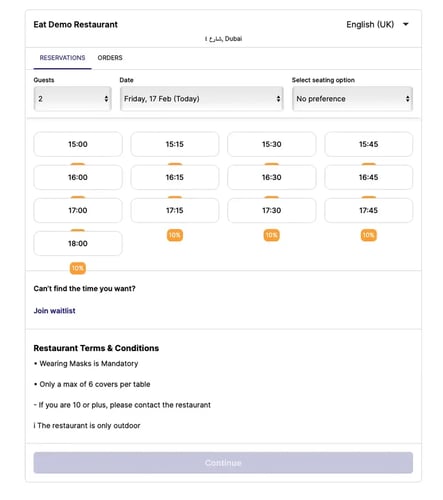
What distinguishes Eat App's virtual restaurant waitlist app from others?
The use of digital waitlist apps is ideal for adding people to a waitlist only as needed.
After your visitors sign up for an online waitlist app, you can:
-
Directly control the public waitlist on your PC, mobile device or any smart device using the table management system
-
Observe estimated wait quotes
-
Guests are notified by text messages when their table is ready
-
Automatically collecting historical data of new guests as well as regular visitors
Eat App’s Restaurant Wait List App is Easy To Use & Offers Flexibility
The virtual waitlist management system for Eat App, compared to the pen and paper waitlist, is made to be simple to set up and adaptable enough to handle changing needs as they appear. Guests can choose their desired time, party size, and any remarks or requirements when they sign up for a waitlist.
- Use it on your website, social media pages, or anywhere else online. Since it is already included in the booking widget, there is no need to install anything else.
- Select one-time or recurring waitlists; you can quickly set up waitlist management for one-time events or repeat them on specific days.
- Choose a date range and time period to define when the waitlist on the waitlist app is accessible.
- Set cover limits to limit capacity and prevent overbooking.
Plus, with Eat App’s waitlist app reporting feature, operators are able to make data-driven business decisions to help improve the guest experience.
Let’s take a look at what the restaurant waitlist apps have to offer in terms of reports.
Eat App’s Digital Waitlist Management and Reporting Analytics
Track important elements of your restaurant's performance, including guests, bookings and waitlists, POS, and more, using one-of-a-kind, in-depth reports that make it simple to share data and spot patterns.
Utilize reports like these to monitor your performance:
Cover flow: To receive the most detailed view of your daily cover trends, get an hourly breakdown of the number of covers at your restaurant on any particular day.
No-show patterns: Have a plan in place to reduce no-shows? Analyze the impact of no-shows. A great feature, especially in the restaurant industry.
Review busy hours: With this report, you may view aggregated data over a period of time to learn when your restaurant is busiest, including the busiest hour during the day, day of the week, week, month, and year.
Additional benefits of Waitlist app Reporting include:
Waitlist app reporting is only one of the many useful reporting tools available to restaurant owners who want to grow their businesses. Waitlist management software offers insights into quote accuracy, typical wait times, abandonment rates, and return times through an integrated data dashboard.
Utilize this information to inform strategic changes for a better visitor experience. Were you over quoting when abandonment rates were highest? Could longer return times—that is, the gap between parties being seated—mean that you should text your guests a little earlier? You can find the answers to these and other questions in these reports.
Now, back to the list of effective ways to help reduce your restaurant’s wait times below.
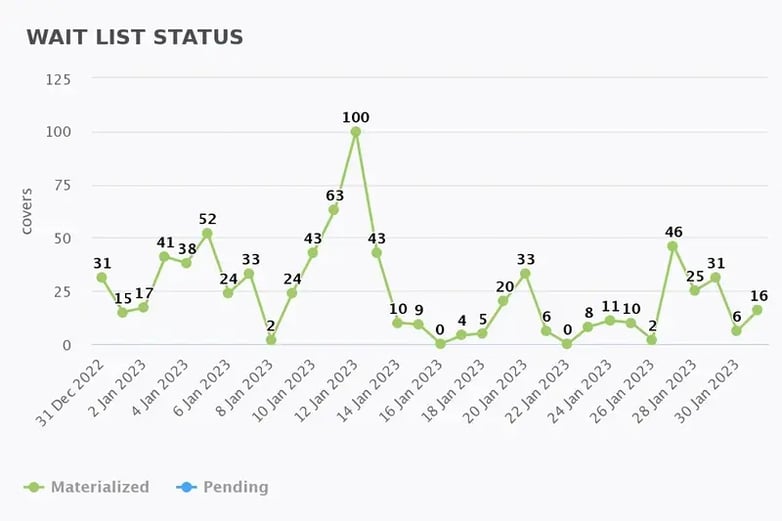
Reconsider front-of-the-house staffing for your front door
You must staff your restaurant appropriately if it also offers takeout in addition to table service. You want to know if guests are waiting for a table or coming in for pick up as they enter the building. Therefore, to staff the take-away portion of your firm, add committed employees in addition to visible signs.
Reduce waiting times and confusion by having an employee divide consumers into groups and check them in during extremely busy times. By including a mobile payment option, staff members may deliver orders right to guests. Additionally, it spares guests from having to wait in line by allowing them to execute their transactions while relaxing in your waiting room or bar.
Renew your bookings process
If your restaurant management only accepts walk-ins yet you frequently draw large crowds and have to turn away clients, it may be time to reconsider your policy. For instance, you can arrange servers in advance if you decide to accept bookings for groups of six or more people. It would go a long way toward reducing crowds to cut down on restaurant wait times even if you choose to accept only a small number of bookings and keep the rest of your tables free for more customers. This can help you arrange staffing and supplies more effectively by giving you a clearer idea of what to anticipate day to day.
The turmoil is brought under control through reservations. You don't want diners leaving your restaurant upset and complaining on social media because they couldn't get a table. So that you may develop a devoted following of pleased guests, you want to have them seated and served within a respectable waiting period.
Let’s review Eat App’s revolutionary booking widget that will help with the above.
Introducing Eat App's new and improved reservation widgets:
With Eat App, your table management system is immediately connected to the reservation widget along with all the essential features.
With the Eat App widget, you can manage the following:
-
Online reservations
-
Select a dining room (indoors, outdoors, etc.)
-
Time-based offers
-
Payments made in advance on reservations
-
Select a customer's table
-
Send text messages to notify a guest that their table is ready via automated messaging
-
Up your customer engagement
-
Review a guest's seated online cover and the table status
-
Promote sister establishments
-
Publicize sporadic events
-
Add guests to a virtual waiting list
-
Finally, ditch the pen and paper
The right waitlist app can now be added to the menu of choices presented by the Eat App widget by subscribing to a (low) flat monthly fee.
Giving guests options is one way to provide a wonderful guest experience, along with making communication with you as easy and hassle-free as you can. Another method for achieving this is through a virtual waitlist app, as mentioned above. Go, view the best waiting list app today!
Strategies for reducing waitlist app abandonment
Despite your best efforts, some guests on the waitlist app may still decide to go somewhere else. With the many options continually thrown their way, it’s easy for them to get distracted. Say the wait is forty-five minutes and they decide to go shopping nearby. This can quickly result in distraction and waitlist abandonment.
SMS notifications are a good way to prevent that from happening and an opportunity to advertise special items on the menu. Be careful not to overdo it, though! With too many advertising texts coming their way, many people can become disengaged. Keep it simple and highlight one particular special. You can get creative here and rotate with the season, time of service, etc.
Even if you are using a service to text customers with updates, another method is to simply keep your guests close and engaged, having them wait in a lounge or at the bar. Many managers join their host/hostess at the stand to help in times of high volume. This can be another prime moment to build excitement and market what you have to offer, but also to answer any questions, share helpful information or mention specials and dishes you are most proud of.
Going beyond SMS in the restaurant industry
If you want to be even more effective at managing waitlists, you should consider using a table management solution. Here are a few of the things you'd be able to do:
-
Assign servers quickly to tables, turning them faster
-
Check-in at any time when tables should become available so that you can set expectations with guests
-
Add potential customers waiting in line and book reservations to the waitlist app and manage your floor plan
-
Have an updated status of how many unexpected guests are on the restaurant waitlists and their estimated wait time
FAQs about Waitlist Apps
FAQs about Waitlist Apps
A waitlist at a restaurant is a strategy to control lines and maintain order in what could otherwise be a stressful scenario. The first stage in the procedure is to keep an organized list that details who is waiting for a table and how many people are in each group. This will help the restaurant manager keep track of whom to serve and when. You must control the line-ups in your restaurant if you don't want to lose clients at this critical time. Fortunately, there are several ways to streamline your operations so that queue management is more efficient at your location.
By offering predicted wait times, a restaurant waitlist template can help you manage walk-ins during busy times and seat customers more quickly. An essential tool for organizing the flow of customers into your establishment is a waitlist for a restaurant.
Guests can easily complete the process: Choose the place you wish to eat at from Google Maps or Search. Click Join waitlist in the restaurant's knowledge panel. Select the party size and add any necessary notes. Requests are displayed above your waitlist, with quick-approval-friendly critical information readily available. Click ‘Done’ to return to the restaurant's knowledge panel.














.webp?width=200&name=v2-15mknc-qpw1b%20(1).webp)
.webp?width=200&name=v2-15kqni-p0exl%20(1).webp)
-1.png?width=1812&height=1072&name=TripAdvisor%20%26%20More%20Bookings%20(1)-1.png)
-2.png?width=1812&height=1072&name=Google%20Bookings%20(1)-2.png)


-1.png?width=200&name=TripAdvisor%20%26%20More%20Bookings%20(1)-1.png)
-2.png?width=200&name=Google%20Bookings%20(1)-2.png)
-1.png?width=200&name=Instagram%20Bookings%20(1)-1.png)
-1-png.webp?width=200&name=Facebook%20Integration%20Rectangle%20(1)-1-png.webp)







.webp?width=200&name=download%20(1).webp)
%20(1)-2.webp?width=200&name=Eat%20(34)%20(1)-2.webp)
%20(1)-2.webp?width=200&name=Eat%20(18)%20(1)-2.webp)






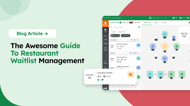


.webp?width=314&height=175&name=image2%20(5).webp)


.webp?width=144&height=72&name=Eat%20App%20Logo%20(3).webp)